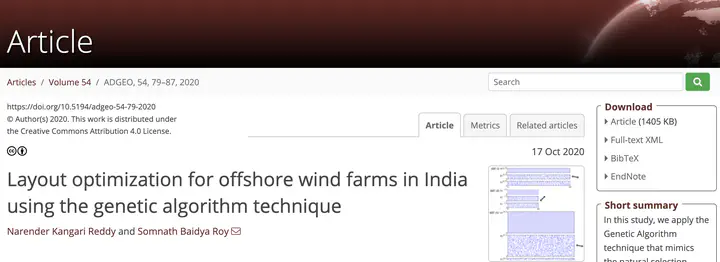Layout optimization for offshore wind farms in India using the genetic algorithm technique
 Publication page
Publication pageAbstract
Wind Farm Layout Optimization Problem (WFLOP) is a critical issue when installing a large wind farm. Many studies have focused on the WFLOP but only for a limited number of turbines and idealized wind speed distributions. In this study, we apply the Genetic Algorithm (GA) to solve the WFLOP for large hypothetical offshore wind farms using real wind data. GA mimics the natural selection process observed in nature, which is the survival of the fittest. The study site is the Palk Strait, located between India and Sri Lanka. This site is a potential hotspot of offshore wind in India. A modified Jensen wake model is used to calculate the wake losses. GA is used to produce optimal layouts for four different wind farms at the specified site. We use two different optimization approaches: one where the number of turbines is kept the same as the thumb rule layout and another where the number of turbines is allowed to vary. The results show that layout optimization leads to large improvements in power generation (up to 28 %), efficiency (up to 34 %), and cost (up to 25 %) compared to the thumb rule due to the reduction in wake losses. Optimized layouts where both the number and locations of turbines are allowed to vary produce better results in terms of efficiency and cost but also leads to lower installed capacity and power generation.
#Click the Cite button above to demo the feature to enable visitors to import publication metadata into their reference management #software.
#Create your slides in Markdown - click the Slides button to check out the example.
#Supplementary notes can be added here, including code, math, and images.